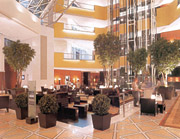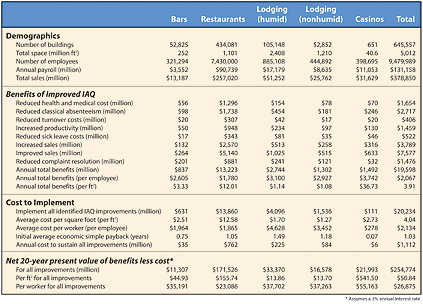
What is the value of increased sales, increased employee productivity, and retention, and less complaints to the hospitality industry (hotels, motels, bars, restaurants, and casinos)? Are you willing to lose almost $4 on every square foot of space? Would you be willing to invest if you received 80% of that investment back each year for the rest of time?
It is all possible, and the changes are simple - focus on maintaining a healthy indoor environment and you will get increased sales due to repeat customers and referrals, improved employee retention and productivity as they enjoy the work environment, and less out-of-pocket expenses to resolve customer complaints.
With over $757 billion in sales and over 60% of the facilities classified as having poor IAQ, there is immense opportunity for easily achieving these savings.
This article presents how this can be attained by reviewing the unique challenges the hospitality industry faces in achieving good IAQ, evaluating the current state of IAQ in the hospitality industry, detailing how to improve IAQ, and reviewing the costs and benefits of such an improvement.

Unique IAQ Challenges
Compared to office buildings and retail, the hospitality industry has unique challenges that must be addressed in achieving acceptable IAQ. These include:
- High density of people: In most hospitality facilities, a large number of people are in a relatively small area and, in turn, there are issues with odors, noise, and transmittal of colds, flu, and other transmittable diseases.
- Beyond design conditions: There can be occasional to frequent occupancy rates that are higher than design ventilation rates. The result is poor dilution or removal of pollutants in the space, especially in bars, conference rooms, casinos, and hotel guest rooms.
- Contact changes: The typical hospitality visitor will be in contact with different people and guests each day, creating a greater opportunity for transmittal of flu and cold viruses, with increased absenteeism of employees and decreased repeat business from guests.
- Higher opportunity for moisture: The prevalent use of packaged units and high occupant density means more plumbing fixtures and HVAC units, which can lead to moisture management problems.
- Pollutant generating activities: Cooking, smoking, off-gassing of materials, and spaces open to outdoors (birds and insects) provide for a greater pollutant generation rate which can tax the systems and result in poor IAQ.
- Higher number of HVAC units: A greater use of smaller units increases the probability of IAQ degradation through the need for more exhaust fans and a higher potential for pressure imbalance.

Current State of IAQ
By using past IAQ studies completed on a variety of building types, a national average classification of wellness can be determined.1 The wellness categories are:
Healthy
- Always meets ASHRAE Standards 62-1999 and 55-1992 during occupied periods.
- 80% or more of the occupants do not express dissatisfaction with indoor air.
- Building systems are well maintained.
- Building health management practices exist.
Generally Healthy
- Meets ASHRAE Standards 62-1999 and 55-1992 during most occupied periods. Examples of items which lead a building to be classified as generally healthy include:

Unhealthy, Source Unknown
- Fails to meet ASHRAE Standards 62-1999 and 55-1992 during most occupied periods.- More than 20% of the building occupants consistently express dissatisfaction with the IAQ.
- Increased occurrence of sick building syndrome (SBS) symptoms but with a complaint rate less than 20% of the occupants.
- Problems exist in the HVAC system and the specific system components with problems can be identified. However, the source of the IAQ and SBS problems cannot be linked to a specific HVAC component.
- Occasional high levels of IAQ-related complaints or symptoms.
Unhealthy, Source Known
- Fails to meet ASHRAE Standards 62-1999 and 55-1992 during most occupied periods.- More than 20% of the building occupants consistently express dissatisfaction with the IAQ.
- Increased occurrence of SBS symptoms but with a complaint rate less than 20% of the occupants.
- Problems exist in the HVAC system, but specific system components with the problems have not been identified.
- Occupants have SBS symptoms and illness related to the IAQ, but which cannot be related specifically to the building.
- Examples of items that cause a building to be classified as unhealthy include:
- One or more cases of building-related illnesses have been documented.
- Occupants report daily symptoms of IAQ-related illness while in the building.
The results of this categorization for an overall national building wellness (all commercial facilities) and that for the hospitality industry are shown in Table 1. The differences between the national values and the various hospitality industry categories are due to the particular challenges faced in the hospitality facilities.
Restaurants
Typically, restaurants face poor maintenance of exhaust hoods, leaky sink pipes, spilled food particles on the floor, and inadequate makeup air, resulting in more frequent breakdowns of systems than in other building types. Therefore, only 50% of the food service buildings are considered healthy buildings, with 35% constituting generally healthy buildings. Unhealthy buildings with sources unknown and known are estimated to constitute 42% of the total number of buildings of this type, with 30% being unhealthy buildings with an unknown source of problems.
Only 8% of the total buildings are considered SBS buildings, because the HVAC systems are relatively small and are maintained more frequently than buildings of other types due to the immediate impact of a system breaking down.
Bars
Bars typically experience a higher level of pollutants and occupancy density, and the conditioning systems are often not sufficient and in poor condition. Consequently, the wellness of these buildings is generally worse than that of restaurants. However, since the problem is known, the unhealthy problem known category increases the most.Lodging (Humid Climate)
Lodging establishments in humid climates have their own challenges due to the high latent load that systems must overcome. Most lodging facilities do not have the proper type of cooling system to be able to control indoor humidity which leads to an environment conducive to the growth of fungi, mold, and microorganisms on the inside walls of ducts, in condensate pans, and on building walls, ceilings, and filters. Poor maintenance, improper air balancing, and improper control strategies aggravate the situation. The maintenance personnel frequently cannot keep up with the system breakdowns or units requiring service.
For the above reasons, 55% of lodging buildings are considered unhealthy buildings, of which 40% are unhealthy buildings with sources unknown, and 15% sources known. Sick buildings constitute 15%. Generally healthy and healthy buildings are estimated at 18% and 12%, respectively.

Lodging (NonHumid Climate)
While there are fewer problems in the general lodging industry than those located in humid climates, there are still problems due to poor maintenance, high traffic in the space, and poor supply and distribution of outdoor air to the occupied spaces. Therefore, 45% of lodging buildings are considered unhealthy buildings, of which 35% are unhealthy buildings with sources unknown, and 10% sources known. Sick buildings constitute 10%. Generally healthy and healthy buildings are estimated at 30% and 15%, respectively.Casinos
Casinos fall between bars and restaurants, in that they have greater pollutant generation than restaurants, but they typically have better conditioning systems and maintenance than most bars. Therefore, 50% of casinos are considered unhealthy buildings, comprising 30% as unhealthy buildings with sources unknown, and 20% with sources known. Sick buildings constitute 10%. Generally healthy and healthy buildings are estimated at 25% and 15%, respectively.How to Improve IAQ
There are multiple opportunities to improve the IAQ in hospitality facilities. For ease of discussion, these opportunities can be divided into two categories of upgrade opportunities:
- Meet or exceed the requirements of ASHRAE Standard 62-1999:
- Change the rate of outdoor air;
- Install demand control;
- Develop smoke and odor control and separation systems;
- Monitor outdoor air quantity to meet ventilation requirements;
- Install local exhaust;
- Increase ventilation effectiveness;
- Maximize economizer cycle;
- Relocate air vents;
- Change the air filtration method; and
- Reduce unwanted infiltration/exfiltration.
- Improve space control to meet the health needs of Standard 62-1999 and meet or exceed the generally accepted requirements of ASHRAE Standard 55-1992:
- Improve space temperature control;
- Improve control or provide positive control of humidity (dehumidification); and
- Install humidification, self-contained steam humidifiers.
Cost to Implement
The estimated capital cost of all the potential IAQ improvements is $20.2 billion with an annual recurring cost of $1.1 billion. The cost breakdown is presented in Table 2.Savings due to Improved IAQ
Accomplishing the improvement of the IAQ to ASHRAE Standard 62-1999 levels is economical for all buildings in the hospitality industry that currently do not meet Standard 62. A summary of the demographics, costs, and benefits calculated in this study are shown in Table 3.Conclusions
We have the ability to improve the health and lifestyle of close to 9.5 million workers in the United States and scores of hospitality facilities. This can be accomplished through the implementation of procedures to maintain the IAQ and comfort to ASHRAE standards. For a one-time investment with a year payback, the savings of over $250 billion dollars net present value for 20 years is staggering. As a nation, we must push forward and institute these changes for ourselves, and our future.
The information contained in this article was gathered under a research grant from the National Energy Management Institute. Their support and foresight on IAQ is greatly appreciated.
EDITOR'S NOTE: Some tables associated with this article do not translate to the Internet. To view the images, please refer to the print version of this month's issue.
Works Cited
1. Burge, S., A. Hedge, S. Wilson, J.H. Bass, and A. Robertson, "Sick Building Syndrome: A Study of 4,373 Office Workers," British Occupational Hygiene Society (1987): 493504.
REFERENCES:
American Gaming Association, AGA Fact Sheets 2000, www.americangaming.org.
American Society of Heating, Refrigerating and Air-Conditioning Engineers (ASHRAE), "Standard 62-1999, Ventilation for Acceptable Indoor Air Quality," Atlanta: ASHRAE, 1999.
American Society of Heating, Refrigerating and Air-Conditioning Engineers (ASHRAE), "Standard 55-1992, Thermal Environmental Conditions for Human Occupancy," Atlanta: ASHRAE, 1992.
Brundage, J.F., R.M. Scott, W.M. Lender, D.W. Smith and R.N. Miller, "Building-Associated Risk of Febrile Acute Respiratory Diseases in Army Trainees," Journal of the American Medical Association, 259, no.14 (April 1988): 2108-2112.
Energy Information Administration, Commercial Buildings Energy Consumption & Expenditures for 1995, Washington, D.C.: United States Department of Energy, 1998.
Putnam, V.L., J.E. Woods and T.A. Bosman, "Objective Measures and Perceived Responses of Air Quality in Two Hospitals," Proceedings of IAQ '89: The Human Equation: Health and Comfort, Atlanta: ASHRAE (April 1989): 241250.
Robertson, A.S., P.S. Burge, A. Hedge, J. Simes, F.S. Gill, M. Finnegan, C.A. Pickering, and G. Dalton, "Comparison of Health Problems Related to Work and Environmental Measurements in Two Office Buildings with Different Ventilation Systems," British Medical Journal (1985): 373376.
Skov, P., O. Valbjorn, B.V. Pedersen, and the Danish Indoor Climate Group, "Influence of Personal Characteristics, Job-Related Factors and Psychosocial Factors on the Sick Building Syndrome," Scandinavian Journal of Work Environmental Health (1989): 286295.
United States Census Bureau, Statistical Abstract of the United States, Washington, D.C.: United States Department of Commerce, 1999, Table 642, p. 404.
Woods, J.E., "Cost Avoidance and Productivity in Owning and Operating Buildings," Occupational Medicine: State of the Art Reviews, 4, no. 4 (Oct. Dec.1989): 753770.
Woods, J.E., G.M. Drewry, and P.R. Morey, "Office Worker Perceptions of Indoor Air Quality Effects on Discomfort and Performance," Proceedings of Indoor Air '87: Fourth International Conference on Indoor Air Quality and Climate 2, Berlin (August 1987): 464468.
